North Korea’s July 19 Local Elections Dispel ROK Allegations of Public Unrest
Summary
The West’s take on North Korean elections is familiar: they are neither free nor fair, neither competitive nor democratic. The thinking, which is echoed in Seoul, is that the uncontested up-or-down votes deny participants any right to substantively express their political preferences or hold their representatives, who are preselected by the regime, accountable for their performance.
The North Korean government’s priorities are different, making the nationwide local elections it held last month an unqualified success from Pyongyang’s perspective. The country’s July 19 electoral process for provincial, city and county people’s assembly members was the first of its kind since Kim Jong Un has assumed power, and like the local elections organized under his father, the event succeeded as a rubber-stamping of prior Workers’ Party of Korea (WPK) leadership determinations. By conducting the polls, party apparatchiks executed an important political task required to maintain the regime’s procedural legitimacy under the new leader and verified the voter registration rolls, an organic element of the population surveillance system.
Little about the July elections can be considered “democratic” in any traditional sense, making the event’s flawless execution all the more noteworthy. They demonstrated impeccable organization by the WPK and created the appearance of normality and political stability, helping to counter Western claims that unrest is spreading throughout North Korea[1][2] and that Kim is losing control of the country. The fact that Kim Jong Un’s regime can organize and see through such a cloistered, noncompetitive process without stirring public discontent suggests it can continue to govern North Korea with its established system of ideological indoctrination, self-censorship and implied coercion. By adhering to the DPRK’s established election procedures, the regime also communicated confidence in its ability to mobilize, control and manipulate the population and local elites as it wishes.
Nationwide Local Elections
On July 19, 2015, North Korea elected deputies of the people’s assemblies of nine provinces and three directly governed municipalities of Pyongyang, Rason and Nampo, 24 cities, 40 urban districts and three “special districts,” as well as 148 counties (in total, 227 local people’s assemblies).[3] In Pyongyang, residents each cast two ballots—one for a deputy of Pyongyang City People’s Assembly and another for a deputy of the particular urban district where they reside (the same rule applied to the residents of Nampo and Rason). Residents of all provinces each cast two ballots—one for a deputy of a corresponding provincial people’s assembly and another for a deputy of a particular provincial city or county where they reside. However, residents of Hamhung and Chongjin each cast three ballots—the first one for a deputy of South or North Hamgyong provincial people’s assembly, respectively, the second one for a deputy of Hamhung City People’s Assembly or Chongjin City People’s Assembly, respectively, and a third one for a deputy of a particular urban district where they reside. Organizers reported that 99.97 percent of eligible voters took part in the July elections and elected 28,452 deputies, unanimously approving all candidates preselected by the WPK.[4] There were no competing candidates; only one was nominated for each electoral district’s seat, in line with the DPRK’s past practice.
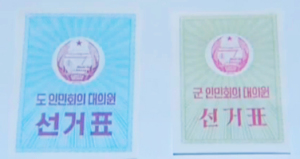
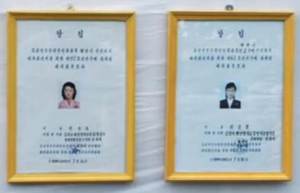
The July elections underscored the stability of Kim Jong Un’s regime. The vote demonstrated the proper functioning of the DPRK’s existing political institutions, and the party propaganda machine used it to showcase Kim’s accomplishments in the past 3.5 years.
The elections also gave Kim Jong Un an opportunity to reshuffle and replace the local elites he inherited from his father in accordance with his own preferences and priorities. His regime replaced 55 percent of Supreme People’s Assembly members in the national parliamentary elections held on March 9, 2014, making it reasonable to expect that the July elections would replace at least 55 percent of local delegates—approximately 15,650 representatives. This rate of turnover would represent a considerable increase in the replacement of local officials under Kim Jong Un; in North Korea’s 2003, 2007 and 2011 local elections, Kim Jong Il’s regime replaced only 43, 44 and 46 percent of delegates, respectively.[5]
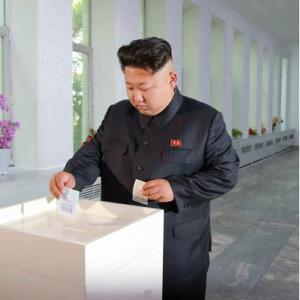
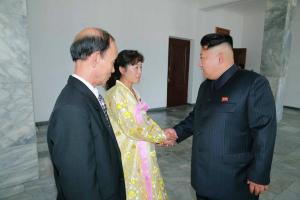
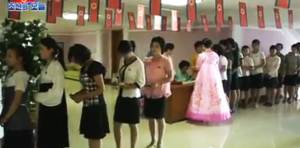
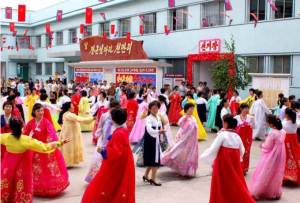
Process
Preparations for the July elections began in June and conformed to established procedures for the local polls, which have taken place every four years.[6] As in past election cycles, planners assigned top priority to the vote’s political and organizational elements: selecting politically acceptable candidates, screening eligible voters, mobilizing participants with help from mass public organizations,[7] and ensuring the “politically correct” counting of all ballots.
Voting is mandatory in North Korea; it is not only a right, but also a duty. All eligible citizens (aged 17 and above) are expected to vote in the country’s electoral system. Those who miss voting without a legitimate excuse—such as fishing in far-away oceans or performing an overseas work assignment—often find themselves in trouble with law enforcement authorities and party functionaries. A key role of election preparations is to verify voter registration information and complete voter rolls. This procedure, which is done by local people’s security departments in collaboration with local party and people’s committees, offers the opportunity for the security services to ascertain the voters’ personal information and identify households where family members are missing or unaccounted for. According to North Korean defectors, some people tend to perceive this procedure as an unwanted invasion of privacy and a part of the government’s extensive surveillance and control of their private lives. In addition, their relatives are allegedly compelled to pay bribes to security officials and election committee staff to avoid retribution for any relatives who have either defected to the South or illegally migrated to China.[8]
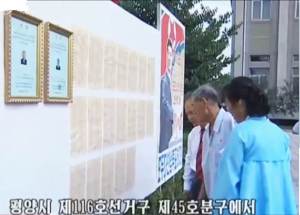
In theory, the local delegates represent workers, peasants, intellectuals and functionaries, and are formally nominated by local working collectives based on recommendations from their respective WPK organizations. In reality, however, they are all selected and vetted by the Organization Departments of the corresponding county, city and provincial WPK committees, and approved by the WPK Central Committee’s Organization and Guidance Department in Pyongyang. Local election committees mentioned below play only a technical role in this process.
In planning the latest local elections, Kim Jong Un’s regime closely followed processes and timelines from elections organized under Kim Il Sung and Kim Jong Il. Tables 1 and 2 offer a basis for comparison.
Table 1. Comparing Local Election Processes from 1999 to 2015: In the Lead Up To Elections.
| SPA Presidium issues initial notice | SPA Presidium establishes Central Election Guidance Committee (CEGC)[9] | Local People’s Committees organize local election committees (LEC) and local electoral districts and precincts[10] | LECs in coordination with MPS begins the verification of the lists of eligible voters | LECs make public the lists of eligible voters | WPK Publishing House distributes election propaganda slogans and posters | Rodong Sinmun publishes the election
editorial |
Voter meetings nominate candidates and discuss their credentials | LECs make public the lists of registered candidates | LECs set up polling stations |
| 26 Jan 1999 | 31 Jan 1999 | 1 Feb 1999 | 2 February 1999 | 19 Feb 1999 | 20 Feb 1999 | 21 Feb 1999 | 23-28 Feb 1999 | 1 Mar 1999 | 5-6 March 1999 |
| 24 June 2003 | 28 June 2003 | 29 June 2003 | 30 June 2003 | 19 July 2003 | 10 July 2003 | 11 July 2003 | 13-15 July 2003 | 31 July 2003 | 1-2 Aug 2003 |
| 18 June 2007 | 23 June 2007 | 26 June 2007 | 27 June 2007 | 14 July 2007 | 15 July 2007 | 16 July 2007 | 18-23 July 2007 | 24 July 2007 | 27-28 July 2007 |
| 13 June 2011 | 18 June 2011 | 21 June 2011 | 22 June 2011 | 9 July 2011 | 9 July 2011 | 10 July 2011 | 15-20 July 2011 | 21 July 2011 | 22-23 July 2011 |
| 8 June 2015 | 13 June 2015 | 16 June 2015 | 17 June 2015 | 9 July 2015 | 9 July 2015 | 10 July 2015 | 10-15 July 2015 | 16 July 2015 | 17-18 Jul 2015 |
Compiled by Alexandre Mansourov, Ph.D.; sources: KCNA, Rodong Sinmun.
Table 2. Comparing Local Election Processes from 1999 to 2015: The Day After.
| DPRK media reports on the supreme leader’s participation in voting | DPRK media reports on the senior leaders’ participation in voting | DPRK media reports on the voters’ reactions on the election day | DPRK media carries the loyalty pledges of the newly elected deputies’ | DPRK media reports on the foreigners’ visits to polling stations | DPRK media reports on festive atmosphere on the election day (dancing parties, concerts, songs) |
| Hamhung branch of Academy of Sciences, Hamhung, South Hamgyong province, (171st electoral district, 72nd precinct) | yes | yes | yes | yes | yes |
| Kim Il Sung Military University, Pyongyang
(658th electoral district, 139nd precinct) |
yes | yes | yes | yes | yes |
| Chusang Cooperative Farm, Hamju County,
South Hamgyong Province |
yes | yes | yes | yes | yes |
| Kim Thae Jong Electric Locomotive Complex,
Sosong district, Pyongyang (107th electoral district, 102nd precinct) |
yes | yes | yes | yes | yes |
Compiled by Alexandre Mansourov, Ph.D.; sources: KCNA, Rodong Sinmun.
Adhering to tradition, the WPK CC Agitation and Propaganda Department framed the elections as an opportunity for voters to express their endorsement of the party’s pre-selected deputies’ appointments. Promotional materials emphasized the vote’s role in demonstrating the “single-hearted unity of the leader, party, army, and masses,” as well as the supposed advantages of “our-style socialism centered on popular masses.” In addition, the party called on voters to “meet the elections with political enthusiasm and labor achievements.” The publicity focused on nationalistic themes, playing up the jingoistic notions that “we are the best” and “our leader, our ideas, and our republic are number one in the world.” As the following graphics show, Kim Jong Un’s regime used propaganda slogans and posters that were substantially similar to materials used under his predecessors. That said, the DPRK media mentioned the Songun (military-first) themes and the KPA’s participation in the elections less often during this latest campaign than in previous local election cycles, potentially reflecting a broader de-emphasis of Songun in recent WPK propaganda and the lower profile of the military in the country’s political life these days.
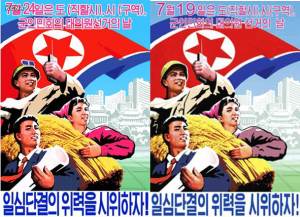

The electoral results under Kim Jong Un’s regime are almost identical to statistics from past elections, as revealed in Table 3. The only notable difference was the number of newly elected local people’s assembly deputies, which increased by 1,062 between the 2011 and 2015 election cycles. This jump probably reflects some recent demographic and administrative changes, such as an increase in voters associated with North Korea’s growing population. The larger number of deputies elected likely also results from the reorganization of certain administrative units (Pyongyang, Nampo, Hamhung, etc.) during the administrative reforms carried out in the early 2010s.[12]
Table 3. Comparing Local Election Results from 1999 to 2015.
| Ballot casting day | Official voter turnout | Official count of votes received by each candidate | Number of deputies elected | Number of complaints reported |
| 7 Mar 1999 | 99.85 | 100 | n.a | 0 |
| 3 Aug 2003 | 99.90 | 100 | 26,650 | 0 |
| 29 July 2007 | 99.82 | 100 | 26,635 | 0 |
| 24 July 2011 | 99.89 | 100 | 27, 390 | 0 |
| 19 July 2015 | 99.97 | 100 | 28, 452 | 0 |
Compiled by Alexandre Mansourov, Ph.D.; sources: KCNA, Rodong Sinmun.
Outlook
With Kim Jong Un’s demand repeatedly stated in all his New Year Addresses and reiterated many times in Rodong Sinmun editorials that the party and state functionaries do their utmost to “raise the people’s living standards,” “serve the people,” and “do more good things for the people,”[13][14] there is a slight chance that the reconstituted local people’s assemblies might pay more attention to the people’s needs, develop more populist policy agendas, and more vigorously advocate for their local constituencies.[15]
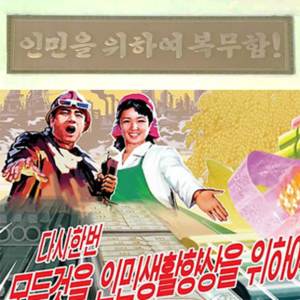
However, if history is any guide, these elections are strictly a formality. It is safe to assume that the newly elected local people’s assemblies will remain silent, invisible and compliant institutions that convene once a year and merely rubber-stamp decisions by the local party and executive body.
————————————————–
[1] “N. Korea holds ambassadors’ meeting amid unrest,” Yonhap, July 15, 2015, http://english.yonhapnews.co.kr/northkorea/2015/07/15/91/0401000000AEN20150715010700320F.html.
[2] Julian Ryall, “Signs of unrest ahead of North Korea elections,” The Telegraph, March 8, 2014, http://www.telegraph.co.uk/news/worldnews/asia/northkorea/10684943/Signs-of-unrest-ahead-of-North-Korea-elections.html.
[3] The system of “local representative governance” is set up and run in accordance with Articles 137 through Article 144 of the DPRK Constitution, as amended in April 2013. Article 138 states that “the local people’s assembly consists of deputies elected on the principle of universal, equal and direct suffrage by secret ballot.” Each province elects its own provincial people’s assembly; each county elects its own county people’s assembly; each city has its own city people’s assembly; and urban districts in Pyongyang, Nampo, Rason, Hamhung, and Chongjin elect their own urban district people’s assemblies. For instance, in Kangwon province, there are Kangwon Provincial People’s Assembly, Wonsan City People’s Assembly and Munch’on City People’s Assembly, and fifteen county people’s assemblies such as Anbyong County People’s Assembly, Sepo County People’s Assembly, and so on. According to Article 139, the term of office of any local people’s assembly is four years.
[4] “Report of Central Election Guidance Commission,” Rodong Sinmun, July 21, 2015, 1, http://www.rodong.rep.kp/ko/index.php?strPageID=SF01_02_01&newsID=2015-07-21-0001.
[5] North Korea’s 2003, 2007, and 2011 local elections respectively elected 26,650, 26,635 and 27,390 delegates to various local people’s assemblies.
[6] In the past two decades, local elections were held on July 24, 2011; July 29, 2007; August 3, 2003; and March 7, 1999. The 2011 vote took place five months before Kim Jong Il’s death.
[7] These organizations include the General Federation of Trade Unions of Korea (GFTUK), the Kim Il Sung Socialist Youth League (KSYL), the Korean Democratic Women’s Union (KDWU) and the Union of Agricultural Workers of Korea (UAWK)
[8] Seok Young Lee, “North Korea to Hold ‘Elections’ in June,” Daily NK, May 31, 2011, http://www.dailynk.com/english/read.php?cataId=nk01500&num=7758.
[9] The Central Election Guidance Committee was chaired by Vice-President of Supreme People’s Assembly (SPA) Presidium Yang Hyong Sop; its vice-chairman was WPK Secretary for cadres Kim Phyong Hae; its secretary general was Secretary-General of SPA Presidium Hong Son Ok. Its members included: Minister of People’s Security Choe Pu Il, Chief Secretary of the Cabinet’s Secretariat Kim Yong Ho, First Secretary of KSYL Chon Yong Nam, Chairman of GFTUK Hyon Sang Ju, Chairman of UAWK Ri Myong Gil, and Chairwoman of KDWU Kim Jong Sun.
[10] Local elections committees in North Korea are usually chaired by the heads of local people’s committees and are made up of local party secretary for cadres, secretary-general of local people’s assembly, director of local people’s security office, a military political officer representing the Korean People’s Army units locally deployed, first secretary of local organization of Kim Il Sung Socialist Youth League, chairman of local organization of General Federation of Trade Unions of Korea, chairman of local organization of Agricultural Workers Union of Korea, and chairwoman of local organization of Korean Democratic Women’s Union.
[11] From time to time, local elections coincide with national elections when their respective four-year and five-year cycles overlap, as it happened in August 1957 or August 2003. I expect the DPRK will hold both local and national elections at the same time in 2019, too, because of this electoral cycle overlap.
[12] “김정일 정권도 이젠 끝날때 됐다,” NKChosun.com, 26 February 2011, http://www.nkchosun.com/news/news.html?ACT=detail&res_id=131414.
[13] “Slogan Representing WPK′s Outlook on People,” KCNA, May 18, 2012.
[14] “Slogan Contains Kim Jong Un′s Outlook on People,” KCNA, May 15, 2012
[15] According to Article 140 of the DPRK Constitution, the local people’s assemblies have the following duties and authority to:
- Deliberate and approve the local plan for the development of the national economy and the report on its implementation;
- Deliberate and approve the local budget and the report on its implementation;
- Adopt measures to observe State laws in the area concerned;
- Elect or recall the Chairman, Vice-Chairmen, Secretary and members of the People’s Committee at the corresponding level;
- Elect or recall the Judges and People’s Assessors of the Court at the corresponding level; and
- Rescind unwarranted decisions and directives of the People’s Committee at the corresponding level and the People’s Assemblies and People’s Committees at lower levels.
